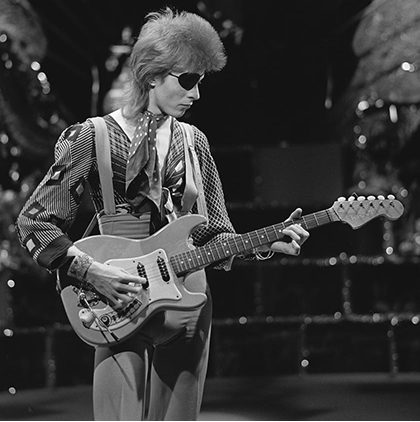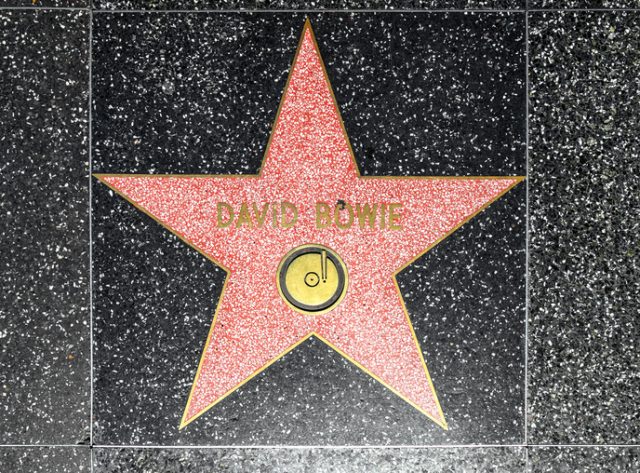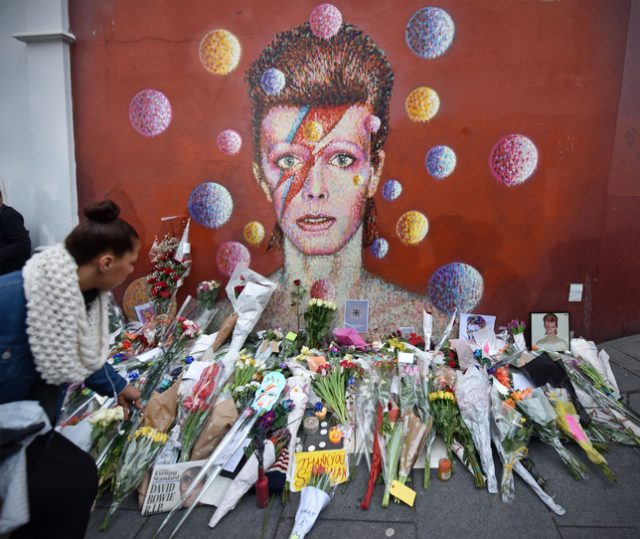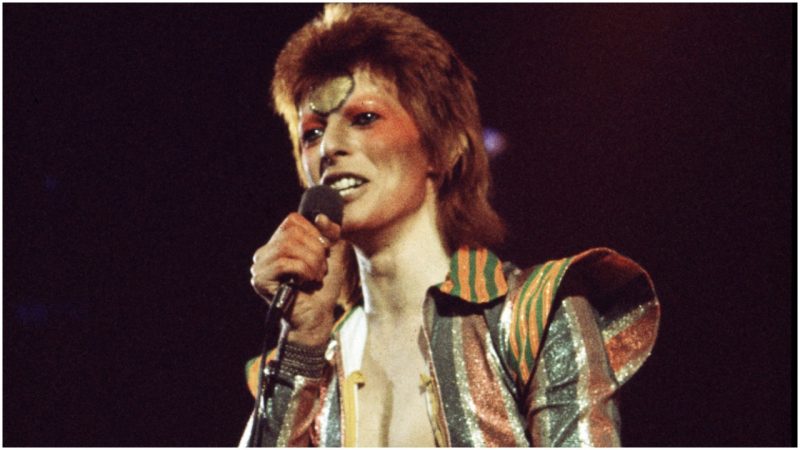“Ground Control to Major Tom.” David Bowie’s portentous and now iconic intonations that open the classic 1969 single “Space Oddity” rocketed the shape-shifting showman to international stardom. His intergalactic interests weren’t just a passing opportunistic fancy, however. From his early Ziggy Stardust days to the late Lazarus farewell, the privately bookish Bowie, who died two days after releasing his last album in 2016, nurtured a lifelong passion for space and science fiction that influenced his artistic output to his finals days.
As a lad (and later as a world-traveling superstar), David Robert Jones was a voracious reader. Among his favorites were George Orwell and Ray Bradbury; he was fascinated by futuristic allegory, existential uncertainty, nightmarish dystopia, and an eventual mashup of technology and fame. (Perhaps unsurprisingly, Bowie also had a life-long interest in Buddhism, clearly in search of some meaning in life.)
An early influence was a 1953 book called, presciently enough, Starman Jones. The children’s novel by Robert A. Heinlein featured a young boy who hopes to travel to the stars with the help of his uncle’s “astrogation” manuals.
When he was just 20, Bowie first sang from the point-of-view of the “man in the moon” in “Love You Till Tuesday” on his 1967 debut album.

But it was “Space Oddity” that launched his fame. That the somewhat bleak song gained traction reflects the fact that cultural interest in space travel and fantasy was at an all-time high in the late 1960s. Bowie was obviously influenced by Stanley Kubrick’s 2001: A Space Odyssey (Space Oddity, get it?). Though some film critics weren’t impressed, the 1968 sci-fi epic quickly gained a cult following, among them Bowie himself. In a 2003 interview, he told Performing Songwriter magazine he found the film “amazing.” Also as a sign of the times, he admitted: “I was very stoned when I went to see it, several times, and it was really a revelation to me. It got the song flowing.”
“Space Oddity” was released just before the launch of Apollo 11, the first mission to send men to the Moon. It was Bowie’s first hit, landing on the U.K. pop charts, though at first some radio stations proclaimed it too bleak to air. British TV, however, used the song as background music for the historic landing. Bowie later laughed that producers must not have paid attention to the lyrics, since the unfortunate Major Tom, floating in his tin can, doesn’t appear to make it back: “Planet Earth is blue and there’s nothing I can do.”
In a pair of proto-music videos, a “Space Oddity” clip filmed in 1969 shows a young red-haired Bowie in Lennon-esque round glasses and a silver space suit with large lettered MAJOR TOM across his chest. The version released in 1972 has the evolving Bowie looking directly into the camera like a dyed-redhead android clad in a form-fitting spankly spacesuit and moon-inappropriate platform boots while he strums his guitar.

From there came his famous incarnation as the androgynous extraterrestrial glam rocker Ziggy Stardust in a hugely successful U.K. concert with the Spiders from Mars. Ziggy was an elaborate theatrical comment on the way rock & roll superstardom created an alienating distance between performers and their fan base. But the character also spoke to anyone who felt like an outlier, which is to say, pretty much any teenager ever.
The single “Starman” was released in April 1972 to promote the album The Rise and Fall of Ziggy Stardust and the Spiders From Mars, released that summer. Bowie’s performance on the show Top of the Pops ensured the album’s quick ascendancy. It stayed in the pop charts for two years, while Bowie and the Spiders toured the U.S.

It seems amazing now, but Bowie considered himself a shy introvert able to perform in public only by inhabiting outlandish theatrical personae. (Which may also help explain his drug addiction.) Ultimately, Bowie had to retire Ziggy because the flamboyant character began to consume Bowie’s low-key offstage private life. “I really did have doubts about my sanity,” Bowie said, according to biographer Christopher Sandford.
Closing out his early space period, Bowie starred as a humanoid alien in Nicolas Roeg’s satirical sci-fi cult-film classic The Man Who Fell to Earth in 1976, though contractual conflicts prohibited him to contribute music to the film. He would continue to come back to his extraterrestrial interests in songs throughout his career—think “Life on Mars?” and “Hallo Spaceboy,” the list goes on and on—but the shapeshifter was moving on to other things.
In a neat twist on life imitating art, an actual astronaut, Chris Hadfield, recorded a hilariously deadpan video of himself singing “Space Oddity” while in orbit on the International Space Station in 2013.

After Bowie’s death in 2016, Belgian astronomers registered a constellation of seven stars near Mars in his honor. The constellation is in the shape of the lightning bolt that appears on Bowie’s face on the cover of the 1973 album Aladdin Sane.
Today, it is poignant and touching to hear the echo of Major Tom’s lament as Bowie sings in the single “Lazarus” from his last album, Blackstar: “Look up here, I’m in heaven … I’ve got nothing left to lose.”
